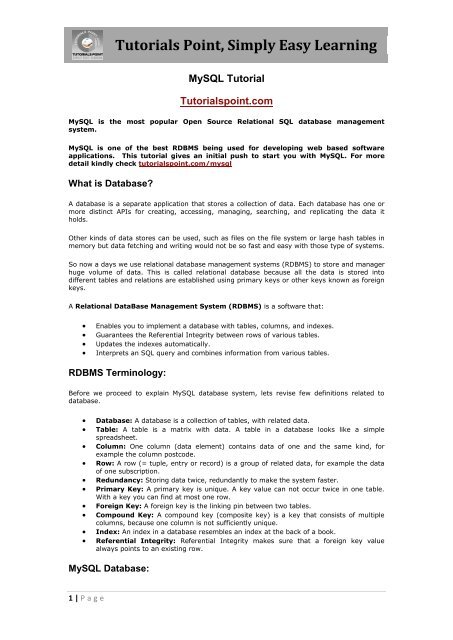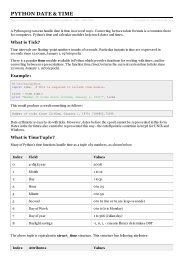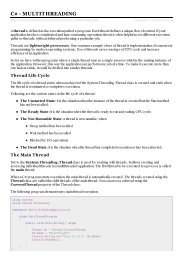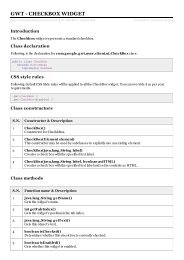Tutorials Point, Simply Easy Learning - TutorialsPoint.com
Tutorials Point, Simply Easy Learning - TutorialsPoint.com
Tutorials Point, Simply Easy Learning - TutorialsPoint.com
You also want an ePaper? Increase the reach of your titles
YUMPU automatically turns print PDFs into web optimized ePapers that Google loves.
1 | P a g e<br />
<strong>Tutorials</strong> <strong>Point</strong>, <strong>Simply</strong> <strong>Easy</strong> <strong>Learning</strong><br />
MySQL Tutorial<br />
<strong>Tutorials</strong>point.<strong>com</strong><br />
MySQL is the most popular Open Source Relational SQL database management<br />
system.<br />
MySQL is one of the best RDBMS being used for developing web based software<br />
applications. This tutorial gives an initial push to start you with MySQL. For more<br />
detail kindly check tutorialspoint.<strong>com</strong>/mysql<br />
What is Database?<br />
A database is a separate application that stores a collection of data. Each database has one or<br />
more distinct APIs for creating, accessing, managing, searching, and replicating the data it<br />
holds.<br />
Other kinds of data stores can be used, such as files on the file system or large hash tables in<br />
memory but data fetching and writing would not be so fast and easy with those type of systems.<br />
So now a days we use relational database management systems (RDBMS) to store and manager<br />
huge volume of data. This is called relational database because all the data is stored into<br />
different tables and relations are established using primary keys or other keys known as foreign<br />
keys.<br />
A Relational DataBase Management System (RDBMS) is a software that:<br />
� Enables you to implement a database with tables, columns, and indexes.<br />
� Guarantees the Referential Integrity between rows of various tables.<br />
� Updates the indexes automatically.<br />
� Interprets an SQL query and <strong>com</strong>bines information from various tables.<br />
RDBMS Terminology:<br />
Before we proceed to explain MySQL database system, lets revise few definitions related to<br />
database.<br />
� Database: A database is a collection of tables, with related data.<br />
� Table: A table is a matrix with data. A table in a database looks like a simple<br />
spreadsheet.<br />
� Column: One column (data element) contains data of one and the same kind, for<br />
example the column postcode.<br />
� Row: A row (= tuple, entry or record) is a group of related data, for example the data<br />
of one subscription.<br />
� Redundancy: Storing data twice, redundantly to make the system faster.<br />
� Primary Key: A primary key is unique. A key value can not occur twice in one table.<br />
With a key you can find at most one row.<br />
� Foreign Key: A foreign key is the linking pin between two tables.<br />
� Compound Key: A <strong>com</strong>pound key (<strong>com</strong>posite key) is a key that consists of multiple<br />
columns, because one column is not sufficiently unique.<br />
� Index: An index in a database resembles an index at the back of a book.<br />
� Referential Integrity: Referential Integrity makes sure that a foreign key value<br />
always points to an existing row.<br />
MySQL Database:
2 | P a g e<br />
<strong>Tutorials</strong> <strong>Point</strong>, <strong>Simply</strong> <strong>Easy</strong> <strong>Learning</strong><br />
MySQL is a fast, easy-to-use RDBMS used being used for many small and big businesses.<br />
MySQL is developed, marketed, and supported by MySQL AB, which is a Swedish <strong>com</strong>pany.<br />
MySQL is be<strong>com</strong>ing so popular because of many good reasons.<br />
� MySQL is released under an open-source license. So you have nothing to pay to use it.<br />
� MySQL is a very powerful program in its own right. It handles a large subset of the<br />
functionality of the most expensive and powerful database packages.<br />
� MySQL uses a standard form of the well-known SQL data language.<br />
� MySQL works on many operating systems and with many languages including PHP,<br />
PERL, C, C++, JAVA etc.<br />
� MySQL works very quickly and works well even with large data sets.<br />
� MySQL is very friendly to PHP, the most appreciated language for web development.<br />
� MySQL supports large databases, up to 50 million rows or more in a table. The default<br />
file size limit for a table is 4GB, but you can increase this (if your operating system can<br />
handle it) to a theoretical limit of 8 million terabytes (TB).<br />
� MySQL is customizable. The open source GPL license allows programmers to modify the<br />
MySQL software to fit their own specific environments.<br />
Before You Begin:<br />
Before you begin this tutorial you should have a basic knowledge of the information covered in<br />
our PHP and HTML tutorials.<br />
This tutorial focuses heavily on using MySQL in a PHP environment. Many examples given in this<br />
tutorial will be useful for PHP Programmers.<br />
We re<strong>com</strong>mend you check our PHP Tutorial for your reference.<br />
Downloading MySQL:<br />
All downloads for MySQL are located at MySQL Downloads. Pick the version number for MySQL<br />
Community Server you want and, as exactly as possible, the platform you want.<br />
Installing MySQL on Linux/Unix<br />
The re<strong>com</strong>mended way to install MySQL on a Linux system is via RPM. MySQL AB makes the<br />
following RPMs available for download on its web site:<br />
� MySQL - The MySQL database server, which manages databases and tables, controls<br />
user access, and processes SQL queries.<br />
� MySQL-client - MySQL client programs, which makes it possible to connect to, and<br />
interact with, the server.<br />
� MySQL-devel - Libraries and header files that <strong>com</strong>e in handy when <strong>com</strong>piling other<br />
programs that use MySQL.<br />
� MySQL-shared - Shared libraries for the MySQL client<br />
� MySQL-bench - Benchmark and performance testing tools for the MySQL database<br />
server.<br />
The MySQL RPMs listed here are all built on a SuSE Linux system, but they.ll usually work on<br />
other Linux variants with no difficulty.<br />
Now follow the following steps to proceed for installation:<br />
1. Login to the system using root user.<br />
2. Switch to the directory containing the RPMs:<br />
3. Install the MySQL database server by executing the following <strong>com</strong>mand. Remember to<br />
replace the filename in italics with the file name of your RPM.
3 | P a g e<br />
<strong>Tutorials</strong> <strong>Point</strong>, <strong>Simply</strong> <strong>Easy</strong> <strong>Learning</strong><br />
[root@host]# rpm -i MySQL-5.0.9-0.i386.rpm<br />
Above <strong>com</strong>mand takes care of installing MySQL server, creating a user of MySQL,<br />
creating necessary configuration and starting MySQL server automatically.<br />
You can find all the MySQL related binaries in /usr/bin and /usr/sbin. All the tables and<br />
databases will be created in /var/lib/mysql directory.<br />
4. This is optional but re<strong>com</strong>mended step to install the remaining RPMs in the same<br />
manner:<br />
[root@host]# rpm -i MySQL-client-5.0.9-0.i386.rpm<br />
[root@host]# rpm -i MySQL-devel-5.0.9-0.i386.rpm<br />
[root@host]# rpm -i MySQL-shared-5.0.9-0.i386.rpm<br />
[root@host]# rpm -i MySQL-bench-5.0.9-0.i386.rpm<br />
Installing MySQL on Windows:<br />
Default installation on any version of Windows is now much easier than it used to be, as MySQL<br />
now <strong>com</strong>es neatly packaged with an installer. <strong>Simply</strong> download the installer package, unzip it<br />
anywhere, and run setup.exe.<br />
Default installer setup.exe will walk you through the trivial process and by default will install<br />
everything under C:\mysql.<br />
Test the server by firing it up from the <strong>com</strong>mand prompt the first time. Go to the location of the<br />
mysqld server, which is probably C:\mysql\bin, and type:<br />
mysqld.exe --console<br />
NOTE: If you are on NT then you will have to use mysqld-nt.exe instead of mysqld.exe<br />
If all went well, you will see some messages about startup and InnoDB. If not, you may have a<br />
permissions issue. Make sure that the directory that holds your data is accessible to whatever<br />
user (probably mysql) the database processes run under.<br />
MySQL will not add itself to the start menu, and there is no particularly nice GUI way to stop the<br />
server either. Therefore, if you tend to start the server by double clicking the mysqld<br />
executable, you should remember to halt the process by hand by using mysqladmin, Task List,<br />
Task Manager, or other Windows-specific means.<br />
Verifying MySQL Installation:<br />
After MySQL has been successfully installed, the base tables have been initialized, and the<br />
server has been started, you can verify that all is working as it should via some simple tests.<br />
Use the mysqladmin Utility to Obtain Server Status:<br />
Use mysqladmin binary to check server version. This binary would be available in /usr/bin on<br />
linux and in C:\mysql\bin on windows.<br />
[root@host]# mysqladmin --version<br />
It will produce following result on Linux. It may vary depending on your installation:
4 | P a g e<br />
<strong>Tutorials</strong> <strong>Point</strong>, <strong>Simply</strong> <strong>Easy</strong> <strong>Learning</strong><br />
mysqladmin Ver 8.23 Distrib 5.0.9-0, for redhat-linux-gnu on i386<br />
If you do not get such message then there may be some problem in your installation and you<br />
would need some help to fix it.<br />
Execute simple SQL <strong>com</strong>mands using MySQL Client:<br />
You can connect to your MySQL server by using MySQL client using mysql <strong>com</strong>mand. At this<br />
momemnt you do not need to give any password as by default it will be set to blank.<br />
So just use following <strong>com</strong>mand<br />
[root@host]# mysql<br />
It should be rewarded with a mysql> prompt. Now you are connected to the MySQL server and<br />
you can execute all the SQL <strong>com</strong>mand at mysql> prompt as follows.<br />
mysql> SHOW DATABASES;<br />
+----------+<br />
| Database |<br />
+----------+<br />
| mysql |<br />
| test |<br />
+----------+<br />
2 rows in set (0.13 sec)<br />
Post-installation Steps:<br />
MySQL ships with a blank password for the root MySQL user. As soon as you have successfully<br />
installed the database and client you need to set a root password as follows:<br />
[root@host]# mysqladmin -u root password "new_password";<br />
Now to make a connection to your MySQL server you would have to use following <strong>com</strong>mand:<br />
[root@host]# mysql -u root -p<br />
Enter password:*******<br />
Unix users will also want to put your MySQL directory in your PATH, so you won't have to keep<br />
typing out the full path every time you want to use the <strong>com</strong>mand-line client. For bash, it would<br />
be something like:<br />
export PATH=$PATH:/usr/bin:/usr/sbin<br />
Running MySQL at boot time:<br />
If you want to run MySQL server at boot time then make sure you have following entry in<br />
/etc/rc.local file<br />
/etc/init.d/mysqld start<br />
Also,you should have mysqld binary in /etc/init.d/ directory.
5 | P a g e<br />
<strong>Tutorials</strong> <strong>Point</strong>, <strong>Simply</strong> <strong>Easy</strong> <strong>Learning</strong><br />
Running and Shutting down MySQL Server:<br />
First check if your MySQL server is running or not. You can use following <strong>com</strong>mand to check<br />
this:<br />
ps -ef | grep mysqld<br />
If your MySql is running then you will see mysqld process listed out in your result. If server is<br />
not running then you can start it by using following <strong>com</strong>mand:<br />
root@hoat# cd /usr/bin<br />
./safe_mysqld &<br />
Now if you want to shutdown an already running MySQL server then you can do it by using<br />
following <strong>com</strong>mand:<br />
root@hoat# cd /usr/bin<br />
./mysqladmin -u root -p shutdown<br />
Enter password: ******<br />
Setting Up a MySQL User Accounts:<br />
For adding a new user to MySQL you just need to add a new entry to user table in database<br />
mysql.<br />
Below is an example of adding new user guest with SELECT, INSERT and UPDATE privileges<br />
with the password guest123 the SQL query is :<br />
root@host# mysql -u root -p<br />
Enter password:*******<br />
mysql> use mysql;<br />
Database changed<br />
mysql> INSERT INTO user<br />
(host, user, password,<br />
select_priv, insert_priv, update_priv)<br />
VALUES ('localhost', 'guest',<br />
PASSWORD('guest123'), 'Y', 'Y', 'Y');<br />
Query OK, 1 row affected (0.20 sec)<br />
mysql> FLUSH PRIVILEGES;<br />
Query OK, 1 row affected (0.01 sec)<br />
mysql> SELECT host, user, password FROM user WHERE user = 'guest';<br />
+-----------+---------+------------------+<br />
| host | user | password |<br />
+-----------+---------+------------------+<br />
| localhost | guest | 6f8c114b58f2ce9e |<br />
+-----------+---------+------------------+<br />
1 row in set (0.00 sec)<br />
When adding a new user remember to encrypt the new password using PASSWORD() function<br />
provided by MySQL. As you can see in the above example the password mypass is encrypted to<br />
6f8c114b58f2ce9e.
6 | P a g e<br />
<strong>Tutorials</strong> <strong>Point</strong>, <strong>Simply</strong> <strong>Easy</strong> <strong>Learning</strong><br />
Notice the FLUSH PRIVILEGES statement. This tells the server to reload the grant tables. If you<br />
don't use it then you won't be able to connect to mysql using the new user account at least until<br />
the server is rebooted.<br />
You can also specify other privileges to a new user by setting the values of following columns in<br />
user table to 'Y' when executing the INSERT query or you can update them later using UPDATE<br />
query.<br />
� Select_priv<br />
� Insert_priv<br />
� Update_priv<br />
� Delete_priv<br />
� Create_priv<br />
� Drop_priv<br />
� Reload_priv<br />
� Shutdown_priv<br />
� Process_priv<br />
� File_priv<br />
� Grant_priv<br />
� References_priv<br />
� Index_priv<br />
� Alter_priv<br />
Another way of adding user account is by using GRANT SQL <strong>com</strong>mand; Following example will<br />
ada user zara with password zara123 for a particular database called TUTORIALS.<br />
root@host# mysql -u root -p password;<br />
Enter password:*******<br />
mysql> use mysql;<br />
Database changed<br />
mysql> GRANT SELECT,INSERT,UPDATE,DELETE,CREATE,DROP<br />
-> ON TUTORIALS.*<br />
-> TO 'zara'@'localhost'<br />
-> IDENTIFIED BY 'zara123';<br />
This will also create an entry in mysql database table called user.<br />
NOTE: MySQL does not terminate a <strong>com</strong>mand until you give a semi colon (;) at the end of SQL<br />
<strong>com</strong>mand.<br />
The /etc/my.cnf File Configuration:<br />
Most of the cases you should not touch this file. By default it will have following entries:<br />
[mysqld]<br />
datadir=/var/lib/mysql<br />
socket=/var/lib/mysql/mysql.sock<br />
[mysql.server]<br />
user=mysql<br />
basedir=/var/lib<br />
[safe_mysqld]<br />
err-log=/var/log/mysqld.log<br />
pid-file=/var/run/mysqld/mysqld.pid
7 | P a g e<br />
<strong>Tutorials</strong> <strong>Point</strong>, <strong>Simply</strong> <strong>Easy</strong> <strong>Learning</strong><br />
Here you can specify a different directory for error log, otherwise you should not change any<br />
entry in this table.<br />
Administrative MySQL Command:<br />
Here is the list of important MySQL <strong>com</strong>mand which you will use time to time to work with<br />
MySQL database:<br />
� USE Databasename : This will be used to select a particular database in MySQL<br />
workarea.<br />
� SHOW DATABASES: Lists the databases that are accessible by the MySQL DBMS.<br />
� SHOW TABLES: Shows the tables in the database once a database has been selected<br />
with the use <strong>com</strong>mand.<br />
� SHOW COLUMNS FROM tablename: Shows the attributes, types of attributes, key<br />
information, whether NULL is permitted, defaults, and other information for a table.<br />
� SHOW INDEX FROM tablename: Presents the details of all indexes on the table,<br />
including the PRIMARY KEY.<br />
� SHOW TABLE STATUS LIKE tablename\G: Reports details of the MySQL DBMS<br />
performance and statistics.<br />
MySQL PHP Syntax<br />
MySQL works very well in <strong>com</strong>bination of various programming languages like PERL, C, C++,<br />
JAVA and PHP. Out of these languages, PHP is the most popular one because of its web<br />
application development capabilities.<br />
This tutorial focuses heavily on using MySQL in a PHP environment. If you are interested in<br />
MySQL with PERL then you can look into PERL and MySQL Tutorial.<br />
PHP provides various functions to access MySQL database and to manipulate data records inside<br />
MySQL database. You would require to call PHP functions in the same way you call any other<br />
PHP function.<br />
The PHP functions for use with MySQL have the following general format:<br />
mysql_function(value,value,...);<br />
The second part of the function name is specific to the function, usually a word that describes<br />
what the function does. The following are two of the functions which we will use in our tutorial<br />
mysqli_connect($connect);<br />
mysqli_query($connect,"SQL statement");<br />
Following example shows a generic sysntax of PHP to call any MySQL function.<br />
<br />
<br />
PHP with MySQL<br />
<br />
<br />
8 | P a g e<br />
<strong>Tutorials</strong> <strong>Point</strong>, <strong>Simply</strong> <strong>Easy</strong> <strong>Learning</strong><br />
}<br />
// Otherwise MySQL or PHP Statements<br />
?><br />
<br />
<br />
Starting from next chapter we will see all the important MySQL functionality along with PHP.<br />
MySQL Database Connection<br />
You can establish MySQL database using mysql binary at <strong>com</strong>mand prompt.<br />
Example:<br />
Here is a simple example to connect to MySQL server from <strong>com</strong>mand prompt:<br />
[root@host]# mysql -u root -p<br />
Enter password:******<br />
This will give you mysql> <strong>com</strong>mand prompt where you will be able to execute any SQL<br />
<strong>com</strong>mand. Following is the result of above <strong>com</strong>mand:<br />
Wel<strong>com</strong>e to the MySQL monitor. Commands end with ; or \g.<br />
Your MySQL connection id is 2854760 to server version: 5.0.9<br />
Type 'help;' or '\h' for help. Type '\c' to clear the buffer.<br />
In above example we have used root as a user but you can use any other user. Any user will be<br />
able to perform all the SQL operation which are allowed to that user.<br />
You can disconnect from MySQL database any time using exit <strong>com</strong>mand at mysql> prompt.<br />
mysql> exit<br />
Bye<br />
MySQL Connection using PHP Script:<br />
PHP provides mysql_connect() function to open a database connection. This function takes<br />
five parameters and returns a MySQL link identifier on success, or FALSE on failure.<br />
Syntax:<br />
connection mysql_connect(server,user,passwd,new_link,client_flag);<br />
Parameter Description<br />
server Optional - The host name running database server. If not specified then<br />
default value is localhost:3036.
9 | P a g e<br />
<strong>Tutorials</strong> <strong>Point</strong>, <strong>Simply</strong> <strong>Easy</strong> <strong>Learning</strong><br />
user Optional - The username accessing the database. If not specified then<br />
default is the name of the user that owns the server process.<br />
passwd Optional - The password of the user accessing the database. If not specified<br />
then default is an empty password.<br />
new_link Optional - If a second call is made to mysql_connect() with the same<br />
arguments, no new connection will be established; instead, the identifier of<br />
the already opened connection will be returned.<br />
client_flags Optional - A <strong>com</strong>bination of the following constants:<br />
� MYSQL_CLIENT_SSL - Use SSL encryption<br />
� MYSQL_CLIENT_COMPRESS - Use <strong>com</strong>pression protocol<br />
� MYSQL_CLIENT_IGNORE_SPACE - Allow space after function names<br />
� MYSQL_CLIENT_INTERACTIVE - Allow interactive timeout seconds of<br />
inactivity before closing the connection<br />
You can disconnect from MySQL database anytime using another PHP function mysql_close().<br />
This function takes a single parameter which is a connection returned by mysql_connect()<br />
function.<br />
Syntax:<br />
bool mysql_close ( resource $link_identifier );<br />
If a resource is not specified then last opened database is closed. This function returns true if it<br />
closes connection successfully otherwise it returns false.<br />
Example:<br />
Try out following example to connect to a MySQL server:<br />
<br />
<br />
Connecting MySQL Server<br />
<br />
<br />
<br />
<br />
10 | P a g e<br />
<strong>Tutorials</strong> <strong>Point</strong>, <strong>Simply</strong> <strong>Easy</strong> <strong>Learning</strong><br />
Create MySQL Database<br />
You would need special privilege to create or to delete a MySQL database. So assuming you<br />
have access to root user, you can create any database using mysql mysqladmin binary.<br />
Example:<br />
Here is a simple example to create database called TUTORIALS:<br />
[root@host]# mysqladmin -u root -p create TUTORIALS<br />
Enter password:******<br />
This will create a MySQL database TUTORIALS.<br />
Create Database using PHP Script:<br />
PHP uses mysql_query function to create or delete a MySQL database. This function takes two<br />
parameters and returns TRUE on success or FALSE on failure.<br />
Syntax:<br />
bool mysql_query( sql, connection );<br />
Parameter Description<br />
sql Required - SQL query to create or delete a MySQL database<br />
connection Optional - if not specified then last opened connection by mysql_connect will<br />
be used.<br />
Example:<br />
Try out following example to create a database:<br />
<br />
<br />
Creating MySQL Database<br />
<br />
<br />
11 | P a g e<br />
<strong>Tutorials</strong> <strong>Point</strong>, <strong>Simply</strong> <strong>Easy</strong> <strong>Learning</strong><br />
if(! $retval )<br />
{<br />
die('Could not create database: ' . mysql_error());<br />
}<br />
echo "Database TUTORIALS created successfully\n";<br />
mysql_close($conn);<br />
?><br />
<br />
<br />
Drop MySQL Database<br />
You would need special privilege to create or to delete a MySQL database. So assuming you<br />
have access to root user, you can create any database using mysql mysqladmin binary.<br />
Be careful while deleting any database because it will lose your all the data available in your<br />
database.<br />
Here is an example to delete a database created in previous chapter:<br />
[root@host]# mysqladmin -u root -p drop TUTORIALS<br />
Enter password:******<br />
This will give you a warning and it will confirm if you really want to delete this database or not.<br />
Dropping the database is potentially a very bad thing to do.<br />
Any data stored in the database will be destroyed.<br />
Do you really want to drop the 'TUTORIALS' database [y/N] y<br />
Database "TUTORIALS" dropped<br />
Drop Database using PHP Script:<br />
PHP uses mysql_query function to create or delete a MySQL database. This function takes two<br />
parameters and returns TRUE on success or FALSE on failure.<br />
Syntax:<br />
bool mysql_query( sql, connection );<br />
Parameter Description<br />
sql Required - SQL query to create or delete a MySQL database<br />
connection Optional - if not specified then last opened connection by mysql_connect will<br />
be used.<br />
Example:<br />
Try out following example to delete a database:
12 | P a g e<br />
<strong>Tutorials</strong> <strong>Point</strong>, <strong>Simply</strong> <strong>Easy</strong> <strong>Learning</strong><br />
<br />
<br />
Deleting MySQL Database<br />
<br />
<br />
<br />
<br />
<br />
WARNING: While deleting a database using PHP script, it does not prompt you for any<br />
confirmation. So be careful while deleting a MySQL database.<br />
Selecting MySQL Database<br />
Once you get connection with MySQL server,it is required to select a particular database to work<br />
with. This is because there may be more than one database available with MySQL Server.<br />
Selecting MySQL Database from Command Prompt:<br />
This is very simple to select a particular database from mysql> prompt. You can use SQL<br />
<strong>com</strong>mand use to select a particular database.<br />
Example:<br />
Here is an example to select database called TUTORIALS:<br />
[root@host]# mysql -u root -p<br />
Enter password:******<br />
mysql> use TUTORIALS;<br />
Database changed<br />
mysql><br />
Now you have selected TUTORIALS database and all the subsequent operations will be<br />
performed on TUTORIALS database.<br />
NOTE: all the database name, table names, table fields name are case sensitive. So you would<br />
have to use prpoer names while giving any SQL <strong>com</strong>mand.
13 | P a g e<br />
<strong>Tutorials</strong> <strong>Point</strong>, <strong>Simply</strong> <strong>Easy</strong> <strong>Learning</strong><br />
Selecting MySQL Database Using PHP Script:<br />
PHP provides function mysql_select_db to select a database.It returns TRUE on success or<br />
FALSE on failure.<br />
Syntax:<br />
bool mysql_select_db( db_name, connection );<br />
Parameter Description<br />
db_name Required - MySQL Database name to be selected<br />
connection Optional - if not specified then last opened connection by mysql_connect will<br />
be used.<br />
Example:<br />
Here is the example showing you how to select a database.<br />
<br />
<br />
Selecting MySQL Database<br />
<br />
<br />
<br />
<br />
<br />
MySQL Data Types<br />
Properly defining the fields in a table is important to the overall optimization of your database.<br />
You should use only the type and size of field you really need to use; don't define a field as 10<br />
characters wide if you know you're only going to use 2 characters. These types of fields (or<br />
columns) are also referred to as data types, after the type of data you will be storing in those<br />
fields.<br />
MySQL uses many different data types, broken into three categories: numeric, date and time,<br />
and string types.<br />
Numeric Data Types:
14 | P a g e<br />
<strong>Tutorials</strong> <strong>Point</strong>, <strong>Simply</strong> <strong>Easy</strong> <strong>Learning</strong><br />
MySQL uses all the standard ANSI SQL numeric data types, so if you're <strong>com</strong>ing to MySQL from a<br />
different database system, these definitions will look familiar to you. The following list shows the<br />
<strong>com</strong>mon numeric data types and their descriptions.<br />
� INT - A normal-sized integer that can be signed or unsigned. If signed, the allowable<br />
range is from -2147483648 to 2147483647. If unsigned, the allowable range is from 0<br />
to 4294967295. You can specify a width of up to 11 digits.<br />
� TINYINT - A very small integer that can be signed or unsigned. If signed, the allowable<br />
range is from -128 to 127. If unsigned, the allowable range is from 0 to 255. You can<br />
specify a width of up to 4 digits.<br />
� SMALLINT - A small integer that can be signed or unsigned. If signed, the allowable<br />
range is from -32768 to 32767. If unsigned, the allowable range is from 0 to 65535.<br />
You can specify a width of up to 5 digits.<br />
� MEDIUMINT - A medium-sized integer that can be signed or unsigned. If signed, the<br />
allowable range is from -8388608 to 8388607. If unsigned, the allowable range is from<br />
0 to 16777215. You can specify a width of up to 9 digits.<br />
� BIGINT - A large integer that can be signed or unsigned. If signed, the allowable range<br />
is from -9223372036854775808 to 9223372036854775807. If unsigned, the allowable<br />
range is from 0 to 18446744073709551615. You can specify a width of up to 11 digits.<br />
� FLOAT(M,D) - A floating-point number that cannot be unsigned. You can define the<br />
display length (M) and the number of decimals (D). This is not required and will default<br />
to 10,2, where 2 is the number of decimals and 10 is the total number of digits<br />
(including decimals). Decimal precision can go to 24 places for a FLOAT.<br />
� DOUBLE(M,D) - A double precision floating-point number that cannot be unsigned.<br />
You can define the display length (M) and the number of decimals (D). This is not<br />
required and will default to 16,4, where 4 is the number of decimals. Decimal precision<br />
can go to 53 places for a DOUBLE. REAL is a synonym for DOUBLE.<br />
� DECIMAL(M,D) - An unpacked floating-point number that cannot be unsigned. In<br />
unpacked decimals, each decimal corresponds to one byte. Defining the display length<br />
(M) and the number of decimals (D) is required. NUMERIC is a synonym for DECIMAL.<br />
Date and Time Types:<br />
The MySQL date and time datatypes are:<br />
� DATE - A date in YYYY-MM-DD format, between 1000-01-01 and 9999-12-31. For<br />
example, December 30th, 1973 would be stored as 1973-12-30.<br />
� DATETIME - A date and time <strong>com</strong>bination in YYYY-MM-DD HH:MM:SS format, between<br />
1000-01-01 00:00:00 and 9999-12-31 23:59:59. For example, 3:30 in the afternoon<br />
on December 30th, 1973 would be stored as 1973-12-30 15:30:00.<br />
� TIMESTAMP - A timestamp between midnight, January 1, 1970 and sometime in 2037.<br />
This looks like the previous DATETIME format, only without the hyphens between<br />
numbers; 3:30 in the afternoon on December 30th, 1973 would be stored as<br />
19731230153000 ( YYYYMMDDHHMMSS ).<br />
� TIME - Stores the time in HH:MM:SS format.<br />
� YEAR(M) - Stores a year in 2-digit or 4-digit format. If the length is specified as 2 (for<br />
example YEAR(2)), YEAR can be 1970 to 2069 (70 to 69). If the length is specified as 4,<br />
YEAR can be 1901 to 2155. The default length is 4.<br />
String Types:<br />
Although numeric and date types are fun, most data you'll store will be in string format. This list<br />
describes the <strong>com</strong>mon string datatypes in MySQL.<br />
� CHAR(M) - A fixed-length string between 1 and 255 characters in length (for example<br />
CHAR(5)), right-padded with spaces to the specified length when stored. Defining a<br />
length is not required, but the default is 1.<br />
� VARCHAR(M) - A variable-length string between 1 and 255 characters in length; for<br />
example VARCHAR(25). You must define a length when creating a VARCHAR field.
15 | P a g e<br />
<strong>Tutorials</strong> <strong>Point</strong>, <strong>Simply</strong> <strong>Easy</strong> <strong>Learning</strong><br />
� BLOB or TEXT - A field with a maximum length of 65535 characters. BLOBs are<br />
"Binary Large Objects" and are used to store large amounts of binary data, such as<br />
images or other types of files. Fields defined as TEXT also hold large amounts of data;<br />
the difference between the two is that sorts and <strong>com</strong>parisons on stored data are case<br />
sensitive on BLOBs and are not case sensitive in TEXT fields. You do not specify a<br />
length with BLOB or TEXT.<br />
� TINYBLOB or TINYTEXT - A BLOB or TEXT column with a maximum length of 255<br />
characters. You do not specify a length with TINYBLOB or TINYTEXT.<br />
� MEDIUMBLOB or MEDIUMTEXT - A BLOB or TEXT column with a maximum length of<br />
16777215 characters. You do not specify a length with MEDIUMBLOB or MEDIUMTEXT.<br />
� LONGBLOB or LONGTEXT - A BLOB or TEXT column with a maximum length of<br />
4294967295 characters. You do not specify a length with LONGBLOB or LONGTEXT.<br />
� ENUM - An enumeration, which is a fancy term for list. When defining an ENUM, you<br />
are creating a list of items from which the value must be selected (or it can be NULL).<br />
For example, if you wanted your field to contain "A" or "B" or "C", you would define<br />
your ENUM as ENUM ('A', 'B', 'C') and only those values (or NULL) could ever populate<br />
that field.<br />
Create MySQL Tables<br />
The table creation <strong>com</strong>mand requires:<br />
� Name of the table<br />
� Names of fields<br />
� Definitions for each field<br />
Syntax:<br />
Here is generic SQL syntax to create a MySQL table:<br />
CREATE TABLE table_name (column_name column_type);<br />
Now we will create following table in TUTORIALS database.<br />
tutorials_tbl(<br />
tutorial_id INT NOT NULL AUTO_INCREMENT,<br />
tutorial_title VARCHAR(100) NOT NULL,<br />
tutorial_author VARCHAR(40) NOT NULL,<br />
submission_date DATE,<br />
PRIMARY KEY ( tutorial_id )<br />
);<br />
Here few items need explanation:<br />
� Field Attribute NOT NULL is being used because we do not want this field to be NULL.<br />
SO if user will try to create a record with NULL value then MySQL will raise an error.<br />
� Field Attribute AUTO_INCREMENT tells to MySQL to go ahead and add the next<br />
available number to the id field.<br />
� Keyword PRIMARY KEY is used to define a column as primary key. You can use<br />
multiple columns separated by <strong>com</strong>ma to define a primary key.<br />
Creating Tables from Command Prompt:<br />
This is easy to create a MySQL table from mysql> prompt. You will use SQL <strong>com</strong>mand CREATE<br />
TABLE to create a table.
Example:<br />
16 | P a g e<br />
<strong>Tutorials</strong> <strong>Point</strong>, <strong>Simply</strong> <strong>Easy</strong> <strong>Learning</strong><br />
Here is an example which creates tutorials_tbl:<br />
root@host# mysql -u root -p<br />
Enter password:*******<br />
mysql> use TUTORIALS;<br />
Database changed<br />
mysql> CREATE TABLE tutorials_tbl(<br />
-> tutorial_id INT NOT NULL AUTO_INCREMENT,<br />
-> tutorial_title VARCHAR(100) NOT NULL,<br />
-> tutorial_author VARCHAR(40) NOT NULL,<br />
-> submission_date DATE,<br />
-> PRIMARY KEY ( tutorial_id )<br />
-> );<br />
Query OK, 0 rows affected (0.16 sec)<br />
mysql><br />
NOTE: MySQL does not terminate a <strong>com</strong>mand until you give a semi colon (;) at the end of SQL<br />
<strong>com</strong>mand.<br />
Creating Tables Using PHP Script:<br />
To create new table in any existing database you would need to use PHP function<br />
mysql_query(). You will pass its second argument with proper SQL <strong>com</strong>mand to create a<br />
table.<br />
Example:<br />
Here is an example to create a table using PHP script:<br />
<br />
<br />
Creating MySQL Tables<br />
<br />
<br />
17 | P a g e<br />
<strong>Tutorials</strong> <strong>Point</strong>, <strong>Simply</strong> <strong>Easy</strong> <strong>Learning</strong><br />
}<br />
echo "Table created successfully\n";<br />
mysql_close($conn);<br />
?><br />
<br />
<br />
Drop MySQL Tables<br />
It is very easy to drop an existing MySQL table. But you need to be very careful while deleting<br />
any existing table because data lost will not be recovered after deleting a table.<br />
Syntax:<br />
Here is generic SQL syntax to drop a MySQL table:<br />
DROP TABLE table_name ;<br />
Dropping Tables from Command Prompt:<br />
This needs just to execute DROP TABLE SQL <strong>com</strong>mand at mysql> prompt.<br />
Example:<br />
Here is an example which deletes tutorials_tbl:<br />
root@host# mysql -u root -p<br />
Enter password:*******<br />
mysql> use TUTORIALS;<br />
Database changed<br />
mysql> DROP TABLE tutorials_tbl<br />
Query OK, 0 rows affected (0.8 sec)<br />
mysql><br />
Dropping Tables Using PHP Script:<br />
To drop an existing table in any database you would need to use PHP function mysql_query().<br />
You will pass its second argument with proper SQL <strong>com</strong>mand to drop a table.<br />
Example:<br />
<br />
<br />
Creating MySQL Tables<br />
<br />
<br />
18 | P a g e<br />
<strong>Tutorials</strong> <strong>Point</strong>, <strong>Simply</strong> <strong>Easy</strong> <strong>Learning</strong><br />
echo 'Connected successfully';<br />
$sql = "DROP TABLE tutorials_tbl";<br />
mysql_select_db( 'TUTORIALS' );<br />
$retval = mysql_query( $sql, $conn );<br />
if(! $retval )<br />
{<br />
die('Could not delete table: ' . mysql_error());<br />
}<br />
echo "Table deleted successfully\n";<br />
mysql_close($conn);<br />
?><br />
<br />
<br />
MySQL Insert Query<br />
To insert data into MySQL table you would need to use SQL INSERT INTO <strong>com</strong>mand. You can<br />
insert data into MySQL table by using mysql> prompt or by using any script like PHP.<br />
Syntax:<br />
Here is generic SQL syntax of INSERT INTO <strong>com</strong>mand to insert data into MySQL table:<br />
INSERT INTO table_name ( field1, field2,...fieldN )<br />
VALUES<br />
( value1, value2,...valueN );<br />
To insert string data types it is required to keep all the values into double or single quote, for<br />
example:- "value".<br />
Inserting Data from Command Prompt:<br />
This will use SQL INSERT INTO <strong>com</strong>mand to insert data into MySQL table tutorials_tbl<br />
Example:<br />
Following example will create 3 records into tutorials_tbl table:<br />
root@host# mysql -u root -p password;<br />
Enter password:*******<br />
mysql> use TUTORIALS;<br />
Database changed<br />
mysql> INSERT INTO tutorials_tbl<br />
->(tutorial_title, tutorial_author, submission_date)<br />
->VALUES<br />
->("Learn PHP", "John Poul", NOW());<br />
Query OK, 1 row affected (0.01 sec)<br />
mysql> INSERT INTO tutorials_tbl<br />
->(tutorial_title, tutorial_author, submission_date)<br />
->VALUES<br />
->("Learn MySQL", "Abdul S", NOW());<br />
Query OK, 1 row affected (0.01 sec)<br />
mysql> INSERT INTO tutorials_tbl<br />
->(tutorial_title, tutorial_author, submission_date)<br />
->VALUES
19 | P a g e<br />
<strong>Tutorials</strong> <strong>Point</strong>, <strong>Simply</strong> <strong>Easy</strong> <strong>Learning</strong><br />
->("JAVA Tutorial", "Sanjay", '2007-05-06');<br />
Query OK, 1 row affected (0.01 sec)<br />
mysql><br />
NOTE: Please note that all the arrow signs (->) are not part of SQL <strong>com</strong>mand they are<br />
indicating a new line and they are created automatically by MySQL prompt while pressing enter<br />
key without giving a semi colon at the end of each line of the <strong>com</strong>mand.<br />
In the above example we have not provided tutorial_id because at the time of table create we<br />
had given AUTO_INCREMENT option for this field. So MySQL takes care of inserting these IDs<br />
automatically. Here NOW() is a MySQL function which returns current date and time.<br />
MySQL SELECT Query<br />
The SQL SELECT <strong>com</strong>mand is used to fetch data from MySQL database. You can use this<br />
<strong>com</strong>mand at mysql> prompt as well as in any script like PHP.<br />
Syntax:<br />
Here is generic SQL syntax of SELECT <strong>com</strong>mand to fetch data from MySQL table:<br />
SELECT field1, field2,...fieldN table_name1, table_name2...<br />
[WHERE Clause]<br />
[OFFSET M ][LIMIT N]<br />
� You can use one or more tables separated by <strong>com</strong>ma to include various condition using<br />
a WHERE clause. But WHERE clause is an optional part of SELECT <strong>com</strong>mand.<br />
� You can fetch one or more fields in a single SELECT <strong>com</strong>mand.<br />
� You can specify star (*) in place of fields. In this case SELECT will return all the fields<br />
� You can specify any condition using WHERE clause.<br />
� You can specify an offset using OFFSET from where SELECT will start returning records.<br />
By default offset is zero<br />
� You can limit the number of returned using LIMIT attribute.<br />
Fetching Data from Command Prompt:<br />
This will use SQL SELECT <strong>com</strong>mand to fetch data from MySQL table tutorials_tbl<br />
Example:<br />
Following example will return all the records from tutorials_tbl table:<br />
root@host# mysql -u root -p password;<br />
Enter password:*******<br />
mysql> use TUTORIALS;<br />
Database changed<br />
mysql> SELECT * from tutorials_tbl<br />
+-------------+----------------+-----------------+-----------------+<br />
| tutorial_id | tutorial_title | tutorial_author | submission_date |<br />
+-------------+----------------+-----------------+-----------------+<br />
| 1 | Learn PHP | John Poul | 2007-05-21 |<br />
| 2 | Learn MySQL | Abdul S | 2007-05-21 |<br />
| 3 | JAVA Tutorial | Sanjay | 2007-05-21 |<br />
+-------------+----------------+-----------------+-----------------+
20 | P a g e<br />
<strong>Tutorials</strong> <strong>Point</strong>, <strong>Simply</strong> <strong>Easy</strong> <strong>Learning</strong><br />
3 rows in set (0.01 sec)<br />
mysql><br />
MySQL WHERE Clause<br />
We have seen SQL SELECT <strong>com</strong>mand to fetch data from MySQL table. We can use a conditional<br />
clause called WHERE clause to filter out results. Using WHERE clause we can specify a selection<br />
criteria to select required records from a table.<br />
Syntax:<br />
Here is generic SQL syntax of SELECT <strong>com</strong>mand with WHERE clause to fetch data from MySQL<br />
table:<br />
SELECT field1, field2,...fieldN table_name1, table_name2...<br />
[WHERE condition1 [AND [OR]] condition2.....<br />
� You can use one or more tables separated by <strong>com</strong>ma to include various condition using<br />
a WHERE clause. But WHERE clause is an optional part of SELECT <strong>com</strong>mand.<br />
� You can specify any condition using WHERE clause.<br />
� You can specify more than one conditions using AND or OR operators.<br />
� A WHERE clause can be used alongwith DELETE or UPDATE SQL <strong>com</strong>mand also to<br />
specify a condition.<br />
The WHERE clause works like a if condition in any programming language. This clause is used<br />
to <strong>com</strong>pare given value with the field value available in MySQl table. If given value from outside<br />
is equal to the available field value in MySQL table then it returns that row.<br />
Here is the list of operators which can be used with WHERE clause.<br />
Assume field A holds 10 and field B holds 20 then:<br />
Operator Description Example<br />
= Checks if the value of two operands is<br />
equal or not, if yes then condition<br />
be<strong>com</strong>es true.<br />
!= Checks if the value of two operands is<br />
equal or not, if values are not equal then<br />
condition be<strong>com</strong>es true.<br />
> Checks if the value of left operand is<br />
greater than the value of right operand,<br />
if yes then condition be<strong>com</strong>es true.<br />
< Checks if the value of left operand is less<br />
than the value of right operand, if yes<br />
then condition be<strong>com</strong>es true.<br />
(A = B) is not true.<br />
(A != B) is true.<br />
(A > B) is not true.<br />
(A < B) is true.
21 | P a g e<br />
<strong>Tutorials</strong> <strong>Point</strong>, <strong>Simply</strong> <strong>Easy</strong> <strong>Learning</strong><br />
>= Checks if the value of left operand is<br />
greater than or equal to the value of<br />
right operand, if yes then condition<br />
be<strong>com</strong>es true.<br />
= B) is not true.<br />
(A use TUTORIALS;<br />
Database changed<br />
mysql> SELECT * from tutorials_tbl WHERE tutorial_author='Sanjay';<br />
+-------------+----------------+-----------------+-----------------+<br />
| tutorial_id | tutorial_title | tutorial_author | submission_date |<br />
+-------------+----------------+-----------------+-----------------+<br />
| 3 | JAVA Tutorial | Sanjay | 2007-05-21 |<br />
+-------------+----------------+-----------------+-----------------+<br />
1 rows in set (0.01 sec)<br />
mysql><br />
All the Unless performing a LIKE <strong>com</strong>parison on a string, the <strong>com</strong>parison is not case sensitive.<br />
You can make your search case sensitive using BINARY keyword as follows.<br />
root@host# mysql -u root -p password;<br />
Enter password:*******<br />
mysql> use TUTORIALS;<br />
Database changed<br />
mysql> SELECT * from tutorials_tbl \<br />
WHERE BINARY tutorial_author='sanjay';<br />
Empty set (0.02 sec)<br />
mysql>
22 | P a g e<br />
<strong>Tutorials</strong> <strong>Point</strong>, <strong>Simply</strong> <strong>Easy</strong> <strong>Learning</strong><br />
MySQL UPDATE Query<br />
There may be a requirement where existing data in a MySQL table need to be modified. You can<br />
do so by using SQL UPDATE <strong>com</strong>mand. This will modify any field value of any MySQL table.<br />
Syntax:<br />
Here is generic SQL syntax of UPDATE <strong>com</strong>mand to modify data into MySQL table:<br />
UPDATE table_name SET field1=new-value1, field2=new-value2<br />
[WHERE Clause]<br />
� You can update one or more field all together.<br />
� You can specify any condition using WHERE clause.<br />
� You can update values in a single table at a time.<br />
The WHERE clause is very useful when you want to update selected rows in a table.<br />
Updating Data from Command Prompt:<br />
This will use SQL UPDATE <strong>com</strong>mand with WHERE clause to update selected data into MySQL<br />
table tutorials_tbl<br />
Example:<br />
Following example will update tutorial_title field for a record having tutorial_id as 3.<br />
root@host# mysql -u root -p password;<br />
Enter password:*******<br />
mysql> use TUTORIALS;<br />
Database changed<br />
mysql> UPDATE tutorials_tbl<br />
-> SET tutorial_title='<strong>Learning</strong> JAVA'<br />
-> WHERE tutorial_id=3;<br />
Query OK, 1 row affected (0.04 sec)<br />
Rows matched: 1 Changed: 1 Warnings: 0<br />
mysql><br />
MySQL DELETE Query<br />
If you want to delete a record from any MySQL table then you can use SQL <strong>com</strong>mand DELETE<br />
FROM. You can use this <strong>com</strong>mand at mysql> prompt as well as in any script like PHP.<br />
Syntax:<br />
Here is generic SQL syntax of DELETE <strong>com</strong>mand to delete data from a MySQL table:<br />
DELETE FROM table_name [WHERE Clause]<br />
� If WHERE clause is not specified then all the records will be deleted from the given<br />
MySQL table.
23 | P a g e<br />
<strong>Tutorials</strong> <strong>Point</strong>, <strong>Simply</strong> <strong>Easy</strong> <strong>Learning</strong><br />
� You can specify any condition using WHERE clause.<br />
� You can delete records in a single table at a time.<br />
The WHERE clause is very useful when you want to delete selected rows in a table.<br />
Deleting Data from Command Prompt:<br />
This will use SQL DELETE <strong>com</strong>mand with WHERE clause to delete selected data into MySQL table<br />
tutorials_tbl<br />
Example:<br />
Following example will delete a record into tutorial_tbl whose tutorial_id is 3.<br />
root@host# mysql -u root -p password;<br />
Enter password:*******<br />
mysql> use TUTORIALS;<br />
Database changed<br />
mysql> DELETE FROM tutorials_tbl WHERE tutorial_id=3;<br />
Query OK, 1 row affected (0.23 sec)<br />
mysql><br />
Further Detail:<br />
Refer to the link http://www.tutorialspoint.<strong>com</strong>/mysql<br />
List of <strong>Tutorials</strong> from <strong>Tutorials</strong><strong>Point</strong>.<strong>com</strong><br />
� Learn JSP<br />
� Learn Servlets<br />
� Learn log4j<br />
� Learn iBATIS<br />
� Learn Java<br />
� Learn JDBC<br />
� Java Examples<br />
� Learn Best Practices<br />
� Learn Python<br />
� Learn Ruby<br />
� Learn Ruby on Rails<br />
� Learn SQL<br />
� Learn MySQL<br />
� Learn AJAX<br />
� Learn C Programming<br />
� Learn C++ Programming<br />
� Learn CGI with PERL<br />
� Learn DLL<br />
� Learn ASP.Net<br />
� Learn HTML<br />
� Learn HTML5<br />
� Learn XHTML<br />
� Learn CSS<br />
� Learn HTTP<br />
� Learn JavaScript<br />
� Learn jQuery<br />
� Learn Prototype<br />
� Learn script.aculo.us<br />
� Web Developer's Guide<br />
� Learn RADIUS<br />
� Learn RSS<br />
� Learn SEO Techniques<br />
� Learn SOAP<br />
� Learn UDDI<br />
� Learn Unix Sockets<br />
� Learn Web Services
24 | P a g e<br />
<strong>Tutorials</strong> <strong>Point</strong>, <strong>Simply</strong> <strong>Easy</strong> <strong>Learning</strong><br />
� Learn ebXML<br />
� Learn Euphoria<br />
� Learn GDB Debugger<br />
� Learn Makefile<br />
� Learn Parrot<br />
� Learn Perl Script<br />
� Learn PHP Script<br />
� Learn Six Sigma<br />
� Learn SEI CMMI<br />
� Learn WiMAX<br />
� Learn Tele<strong>com</strong> Billing<br />
� Learn XML-RPC<br />
� Learn UML<br />
� Learn UNIX<br />
� Learn WSDL<br />
� Learn i-Mode<br />
� Learn GPRS<br />
� Learn GSM<br />
� Learn WAP<br />
� Learn WML<br />
� Learn Wi-Fi<br />
webmaster@<strong>Tutorials</strong><strong>Point</strong>.<strong>com</strong>

















